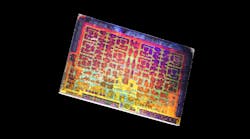With Funding Linked to China, Canyon Bridge Agrees to Buy Imagination
Canyon Bridge – a private equity firm that raised funds tied to the Chinese government, plotted to buy Lattice Semiconductor for $1.3 billion, stumbled into a venomous proxy battle with another chipmaker, and appealed to President Trump to approve the deal after regulators rejected it twice – is moving onto another target.
On Friday, the financial firm said that it would pay around $742.5 million for the tattered remains of Imagination Technologies, which licenses graphics and video-processing technology to chip companies. Graphics chips were invented for rendering video games but are now used to run artificial intelligence tasks like image recognition.
The proposed deal ends months of speculation over Imagination’s fate. The U.K.-based company has been floundering since Apple disclosed plans to phase out Imagination’s graphics technology from its smartphones, tablets, and other gadgets. In the months after losing its biggest customer by revenue, Imagination has been looking for buyers.
The sale is a pivot for Canyon Bridge, which abandoned the Lattice deal after failing to shake concerns about its byzantine Chinese ties. Last year, the firm raised $1.5 billion from Yitai Capital, which is largely funded by China Venture Capital Fund, which is bankrolled by China Reform Holdings, which owns another fund linked to Canyon Bridge’s founders.
Benjamin Chow, one of the founders, was managing director of China Reform Fund Management for nine months last year. The ownership of the fund, which was founded in 2014, can be traced to an asset management firm under the control of the Chinese government, according to China Reform's website.
Since it announced the Lattice acquisition last November, Canyon Bridge filed two applications with the Committee on Foreign Investment in the United States, also known as CFIUS. Both times, the agency recommended against the deal, which is usually enough to stop foreign technology deals.
During the regulatory reviews, another one of Canyon Bridge’s founders, Ray Bingham, the former chief executive of Cadence, resigned from the board of Cypress Semiconductor after a lengthy proxy battle over potential conflicts of interest. He also resigned from Oracle’s board over concerns that he could complicate its business with the U.S. government.
On September 1, Canyon Bridge appealed to Trump to approve the deal, arguing that it would double the number of jobs at the Oregon-based Lattice. The firm bet that the potential job growth would override the government's concerns about technology transfers to China, which is spending billions of dollars in subsidies to become a semiconductor superpower.
Trump ultimately rejected the deal on national security grounds, and the Treasury Department said after the announcement that the risks to the government’s chip supply chain were too steep. Though it doesn't sell to the U.S. military, Lattice sells FPGAs that can withstand high temperatures and could be used in radar and missile defense systems.
Lattice has been caught in the crossfire of China’s plot to improve its semiconductor industry before. In 2012, the Federal Bureau of Investigation charged two Chinese nationals with espionage after they assumed fake names and identities to buy Lattice chips and send them to China illegally.
In its latest deal, Canyon Bridge appears to be taking precautions against further regulatory blockage. Imagination is selling its MIPS business unit as a condition for the deal with Canyon Bridge, which is paying a premium of 41.6% to Imagination’s Friday stock price. MIPS processors are mostly used in embedded computing.
Imagination said on Friday that the American investment firm Tallwood Venture Capital would pay $65 million for the MIPS business, which is based in the United States. The MIPS architecture is used, for example, in Mediatek’s smartphone modems and Mobileye’s image processors for semi-autonomous cars.
The sale could stop Imagination’s downward spiral after losing Apple's business. Apple is already using custom graphics in its latest generation of iPhones to run augmented reality games and artificial intelligence tasks. It is not clear yet when Apple will cut Imagination out of its other gadgets.
When Imagination announced the loss of Apple’s business in April, it had already been grappling with competition from Arm, which also designs graphics chips. In May, the company said that it would stay afloat by selling its Ensigma and MIPS units. In June – after its stock price had plunged – Imagination said everything had to go.
Andrew Heath, Imagination’s chief executive officer, said in a statement that the company had “made excellent progress both operationally and financially over the last 18 months until Apple’s unsubstantiated assertions and the subsequent dispute forced us to change course.” Imagination’s board members have pledged support for the deal.
Canyon Bridge said in a statement that it plans to further invest in Imagination and fan out its business globally. “With our backing and investment Imagination can continue to invest in developing its technology, attract and hire the best engineers, and acquire and service customers globally," Bingham said in a statement.
“This transaction is in line with Canyon Bridge's strategy of providing equity and strategic capital to enable technology companies to reach their full growth potential by opening new markets,” he added. “We are investing in U.K. talent and expertise in order to accelerate the expansion of Imagination, particularly into Asia.”

